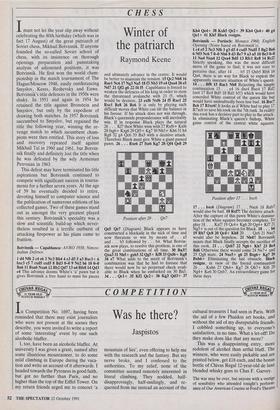CHESS
Winter of the patriarch
Raymond Keene
I must not let the year slip away without celebrating the 80th birthday (which was in fact 17 August) of the great patriarch of Soviet chess, Mikhail Botvinnik. If anyone founded the so-called Soviet school of chess, with its insistence on thorough openings preparation and painstaking analysis of adjourned positions, it was Botvinnik. He first won the world cham- pionship in the match tournament of The Hague/Moscow 1948, easily outdistancing Smyslov, Keres, Reshevsky and Euwe. Botvinnik's title defences in the 1950s were shaky. In 1951 and again in 1954 he retained the title against Bronstein and Smyslov, but only by the expedient of drawing both matches. In 1957 Botvinnik succumbed to Smyslov, but regained the title the following year, winning the re- venge match to which incumbent cham- pions were then entitled. This story of loss and recovery repeated itself against Mikhail Tal in 1960 and 1961, but Botvin- nik finally and definitely lost the title when he was defeated by the wily Armenian Petrosian in 1963.
This defeat may have terminated his title aspirations but Botvinnik continued to compete with significant success in tourna- ments for a further seven years. At the age of 59 he eventually decided to retire, devoting himself to computer science and the publication of numerous editions of his collected games. Two of these games stand out as amongst the very greatest played this century. Botvinnik's speciality was a slow and scientific build-up which never- theless resulted in a terrific outburst of attacking firepower as his plans came to fruition.
Botvinnik — Capablanca: AVRO 1938; Nimzo- Indian Defence.
1 d4 Nf6 2 c4 e6 3 Nc3.Bb4 4 e3 d5 5 a3 Bxc3 + 6 c4 This advance dooms White's 'a' pawn but it bxc3 c5 7 cxd5 exd5 8 Bd3 0-0 9 Ne2 b6 10 0-0 gives Botvinnik a free hand to mass his pieces Ba6 11 Bxa6 Nxa6 12 Bb2 Qd7 13 a4 Rfe8 14 Qd3 and ultimately advance in the centre. It would be better to maintain the tension. 15 Qc2 Nb8 16 Rael Nc6 17 Ng3 Nay 18 f3 Nb3 19 e4 Qxa4 20 e5 Nd7 21 Qf2 g6 22 f4 f5 Capablanca is forced to weaken the defences of his king in order to stem the threatened avalanche with 23 f5, which would be decisive. 23 exf6 Nxf6 24 f5 Rxel 25 Rxel Re8 26 Re6 It is only by playing such difficult moves that White can tilt the balance in his favour. If his attack does not win through, Black's queenside preponderance will inevitably win. If in response Black plays the natural 26 . . Kf7 then White wins with 27 Rxf6+ Kxf6 28 fxg6+ Kxg6 29 Of5+ Kg7 30 Nh5+ Kh6 31 h4 Rg8 32 g4 Qc6 33 Ba3 with a decisive attack. Therefore Black must give White a giant passed pawn. 26 . . . Rxe6 27 fxe6 Kg7 28 Qf4 Qe8 29 Qe5 Qe7 (Diagram) Black appears to have constructed a blockade in the nick of time and now threatens to win by means of . . . a5 and . . . b5 followed by . . . b4. What Botvin- nik now plays, to resolve this problem, is one of the great combinations of all time. 30 Ba3!! Qxa3 31 Nh5+ gxh5 32 QgS+ Kf8 33 Qxf6+ Kg8 34 e7 What adds to the merit of Botvinnik's combination was that he had to foresee that there would now be no perpetual check avail- able to Black when he embarked on 30 Ba3. 34 . . Qcl+ 35 Kf2 Qc2+ 36 Kg3 Qd3+ 37
Position after 29 . . Qe7
Kh4 Qe4+ 38 Kxh5 Qe2+ 39 Kh4 Qe4+ 40 g4 Qel+ 41 Kh5 Black resigns.
Botvinnik — Portisch: Monaco 1968; English Opening (Notes based on Botvinnik's). 1 c4 e5 2 Nc3 Nf6 3 g3 d5 4 cxd5 NxdS 5 Bg2 Be6 6 Nf3 Nc6 7 0-0 Nb6 8 d3 Be7 9 a3 a5 10 Be3 0-0 11 Na4 Nxa4 12 Qxa4 Bd5 13 Rfc1 Re8 14 Rat Strictly speaking, this was the most difficult move of the game to find; it was not easy to perceive that, after 14 . . b5 15 Qxb5 Rb8 16 Qa4, there is no way for Black to exploit the apparently insecure situation of White's queen- 14 . . . Bf8 15 Racl Nb8 Rejecting the simple continuation 15 . . . e4 16 dxe4 Bxe4 17 Rd2 (not 17 Rc4 Bd5 18 Rdl b5!) which would have conceded White control of the queen file but would have undoubtedly been less bad. 16 Rxci Bc6 17 R1xe6! It looks as if White had to play 17 R7xc6 to save his rook on the 7th rank. In reality this rook has a decisive part to play in the attack. In eliminating Black's queen's bishop, White gains control of the central white squares.
Position after 17.. . . bxc6 17 . . . bxc6 (Diagram) 17 . . . Nxc6 18 Rxb7 would also be bad. 18 Rxf7! The decisive attack- After the capture of this pawn White's domina- tion of the white squares becomes complete. To play 18 . . . Kxf7 19 0c4+ Kg6 20 0g4+ Kf7 21 Ng5+ is out of the question for Black. 18 . . h6 19 Rb7 Qc8 20 Qc4+ KM 20 . . Qe6 21 NxeS would also be hopeless. 21 Nh4!! Botvinnik insists that Black finally accepts the sacrifice of this rook. 21 . . . Qxb7 22 Ng6+ Kh7 23 Be4 Bd6 Otherwise there would come 24 Ne7+ and 25 Qg8 mate. 24 NxeS+ g6 25 Bxg6+ Kg7 26 Bxh6+ Eliminating the last obstacle. Black resigns, in view of the forced continuation 26 . . Kxh6 27 Qh4+ Kg7 28 0h7+ Kf6 29 Ng4+ Ke6 30 Qxb7. An extraordinary game for these days.


























































 Previous page
Previous page